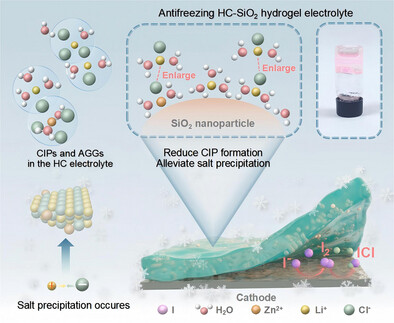Title: SiO2 Nanoparticles-Induced Antifreezing Hydrogel Electrolyte Enables Zn–I2 Batteries with Complete and Reversible Four-Electron-Transfer Mechanisms at Low Temperatures
Authors: Minghui Chen, Guanhong Chen, Chenxi Sun, Xinyu Li, Minghao Zhang, Haiming Hua, Jinbao Zhao*, Yang Yang*
Abstract: Four-electron-transfer aqueous zinc–iodine batteries hold significant promise for large-scale energy storage due to their high specific capacities. However, achieving four-electron-transfer mechanisms under subzero temperatures remains challenging due to freezing point limitations of conventional aqueous electrolytes and sluggish reaction kinetics. Herein, an antifreezing hydrogel electrolyte (HC-SiO2) is developed through the spontaneous gelation of a high-concentration electrolyte (1 m Zn(OAc)2 + 21 m LiCl, HC) with SiO2 nanoparticles, enabling low-temperature operation of quasi-solid-state Zn–I2 batteries with complete and reversible four-electron-transfer processes. Abundant interactions between dispersed SiO2 nanoparticles and cations enlarge ion-pair distances, reducing close ion-pair formation and lowering the freezing temperature (−60.7 °C). Furthermore, the quasi-solid-state hydrogel electrolyte combines advantages of reduced water activity and disrupted hydrogen-bond networks, effectively suppressing I+ hydrolysis while inhibiting ice nucleation. Additionally, the utilization of low-concentration Zn(OAc)2 combined with high-concentration LiCl increases availability of free Cl− by mitigating strong ionic interaction in conventional ZnCl2-based concentrated electrolytes, thereby enhancing reaction kinetics of the I2/I+ conversion. Benefiting from synergistic manipulation of ionic interaction, water activity, and Cl− activity, the HC-SiO2 hydrogel achieves a high capacity of 490.9 mAh g−1 and durable lifespan exceeding 11,000 cycles at −20 °C. These findings offer valuable insights for advancing practical low-temperature Zn–I2 batteries.

Full-Link: https://onlinelibrary.wiley.com/doi/10.1002/anie.202502005